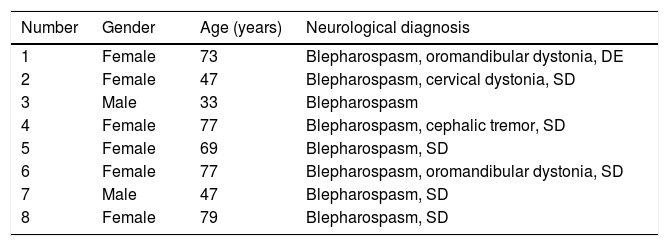Meige syndrome (MS) is part of the group of segmental cranial dystonias, which affect more than two cranial muscle groups. Specifically, blepharospasm is associated with another cranial dystonia (oromandibular, cervical or laryngeal). The aim of this paper was to report our experience in patients with spasmodic dysphonia (SD) associated with primary MS.
Material and methodsA retrospective study involving 8 patients between May 2010 and June 2015. Variables recorded were: age, sex, associated dystonia, electromyographic pattern in laryngeal muscles and treatment given. Outcomes after treatment were assessed using GRBAS(i) scale and VHI-30 questionnaire, always provided by the same examiner.
ResultsFifty-six patients with MS were treated in the Neurology Department. Eight patients of 56 were diagnosed with SD (prevalence of 14%). All of our patients had adductor SD. The median age was 71 years. All the patients were treated with intralaryngeal botulinum toxin under electromyographic control. Clinically relevant improvements were found after treatment on both the GRBAS(i) scale and the VHI-30 questionnaire.
ConclusionIn the study of SD, we should always rule out an association with MS. From the point of view of otorhinolaryngology, the joint use of the GRBAS(i) scale and the VHI-30 questionnaire are useful, reliable and efficient methods for assessing progress and response to treatment. Laryngeal infiltration under electromyographic control with botulinum toxin is the therapeutic alternative that provides better results. The management of SD associated with MS does not differ from isolated SD.
El síndrome de Meige (SM) es considerado una distonía craneal segmentaria que afecta a dos o más músculos craneales. Específicamente, asocia blefaroespasmo a otra distonía craneal (oromandibular, cervical o laríngea). El objetivo de este artículo es presentar nuestra experiencia clínica en pacientes con disfonía espasmódica (DE) asociada a SM primario.
Material y métodosEstudio retrospectivo realizado entre mayo de 2010 y junio de 2015. Incluyó 8 pacientes. Las variables recogidas fueron: sexo, edad, distonías asociadas, electromiografía laríngea y tratamiento. Los resultados clínicos objetivados fueron realizados, siempre por el mismo investigador, con la escala GRBAS(i) y el cuestionario VHI-30.
ResultadosCincuenta y seis pacientes fueron tratados de SM por el servicio de Neurología. Ocho pacientes asociaron DE (prevalencia 14%). El 100% de nuestros pacientes tenían DE aductora. La mediana de edad para la aparición de DE fue de 71 años. Todos los pacientes fueron tratados con infiltración intralaríngea de toxina botulínica bajo control electromiográfico. Se objetivó mejoría clínica tanto en la escala GRBAS(i) como en los cuestionarios VHI-30.
ConclusiónEn el estudio de la DE siempre debe tenerse presente su posible asociación con el SM. Desde el punto de vista otorrinolaringológico, el uso conjunto de la escala GRBAS(i) y los cuestionarios VHI-30 es útil, fiable y eficiente como método para evaluar evolución y respuesta a tratamiento. La infiltración laríngea de toxina botulínica bajo control electromiográfico es la alternativa terapéutica que provee mejores resultados clínicos. El manejo de la DE asociada al SM no difiere del de la DE aislada.








